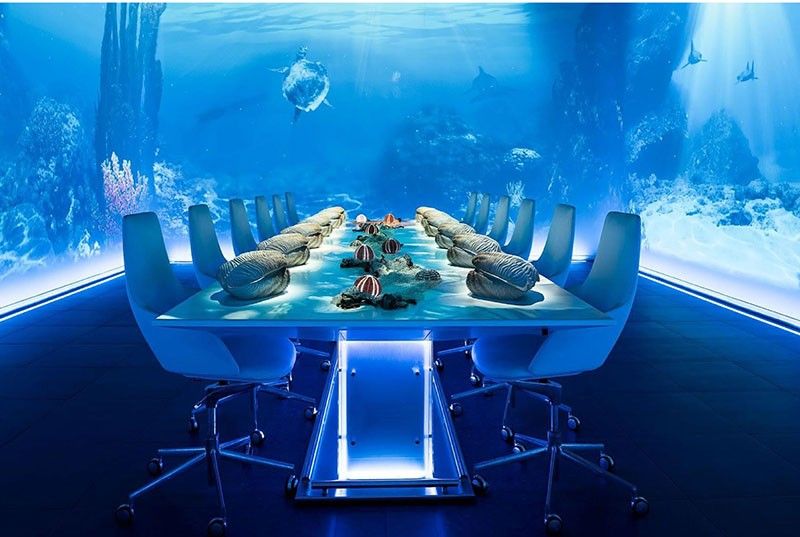High-end dining in the age of political correctness: An evening at the most expensive restaurant on earth


How I wound up dining at the Most Expensive Restaurant on Earth is a long story, so I won’t bore you with it, but rest assured it was not because I had money to burn and a few gears loose. Still, I will venture that if you are of good character, think positive, and trust in a just God, sometimes happy things will come your way, such as free meals from acquaintances with liberal expense accounts.
Good luck has often come to me gastronomically. A few years back, planning to pass through San Francisco, I invited an old friend and his wife to dinner.
“I’ll make the reservations,” he said. “Where do you want to take us?”
“French Laundry,” said I, confident that in those days no one could get into French Laundry without waiting a year. But evidently, my friend is hot stuff in the Bay Area. A few days later, the manager was showing us to what was clearly French Laundry’s best table. Celebrity chef-owner Thomas Keller had left handwritten welcome cards for each of us, and eventually comped our whole meal, Batard-Montrachet and all, to apologize for not being there in person that night. (For the exciting story of how I was saved from financial ruin and even got a free meal, Google “Philstar Counting Stars from Manhattan to San Francisco.” Must be good karma to make up for all the other undeserved disappointments in my mostly blameless life.)
Not too long ago, luxury-lifestyle magazine Robb Report took a stab at naming “The 30 most influential restaurants of the past 30 years,” wisely giving itself lots of wiggle room and avoiding sticking its neck out on who was number one.

Less shy, a British publication has been naming the World’s 50 Best restaurants and, of course, The Best, since 2002.
Is there such a thing? Surely not. “Best” is a matter of context and of personal mood. On any average day, given a choice between a KFC spicy-crispy thigh and, say, Copenhagen’s Noma (five times voted “World’s Best Restaurant”), I would go for the fried chicken, especially the KFC in one particular country. (I actually came close to eating at Noma once, but they were on an All Forest-Vegetable kick, so I missed my big chance. Their menus looked exhausting, and too virtuous by far.)
There is, however, one restaurant superlative that is objective, verifiable, and really not arguable, and that is “Most Expensive.”

Hang on to your seats, because the holder of this title is… Sublimotion, in Ibiza, Spain! Whoa! Who? Where? And, to cut to the money, how much?
To answer the last question first, 2,000 euros. One person. One meal (though a long one). That’s five to 10 times the cost at its culinary rivals.
When I ate at Eleven Madison Park (another World’s Best winner) in 2017 with my son Rafael and nephew Rocky, it was a mere US$300 per head for the food and another $300 for the high-end wine pairing. And, apparently mistaking us for someone important, the management even threw in a tour of the kitchen, usually reserved for Manhattan heavy hitters.
As for the bill at Spago (which is on Robb Report’s list), I can’t remember how much it was, because the highlight of that meal was my other son, Gabriel, ordering “plain boiled spaghetti, no sauce.” He was 11 then.
Ibiza is, of course, the famous party island whose reputation has vastly outgrown its modest, original charms, which were a rural feel, lots of sun, and a tolerant attitude to sex, drugs, and gender identities. Now it’s mostly just jampacked night clubs and sardine-size swimming pools.

Sublimotion is a very unusual restaurant, composed of a single room loaded with technical wizardry, and a single table for exactly 12 diners. It offers you not just a meal, but an Augmented-Reality, Time-Travelling, Globetrotting, Fantasy-Dining Experience. (My mouthful, not theirs.)
After a brief welcome song by our attractive mistress of ceremonies, we 12 diners — all guests of the same host — were tipped into our swivel chairs. Immediately the walls, floor, and table started morphing into alarming galaxy-warp patterns. Twelve servers brought in our first course, a full 50-gram portion of caviar on some kind of aspic. It was paired with Perrier-Jouet Belle E?poque, which was poured as fast as we could chug. Actually we didn’t chug; we all sipped daintily, though perhaps a little fast.
The room then dissolved into a live underwater scene with frolicking dolphins and shoals of fish, making us feel as if we were in a bottom-of-the-sea secret chamber, a la James Bond villain. Cool.
If you promise not to tell my host, let me sneak in a comment. While by no means an expert on the subject, I judged the caviar sub-par, and quickly settled on a conspiracy theory. What with the Ukraine war, endangered species, and oligarch sanctions, genuine Russian caviar has become an iffy, un-cool proposition. You can almost hear a shadowy voice in the Kremlin: “Seize our yachts, will you? Well, Decadent Capitalists, we’re weaponizing our caviar. Only over-salted Chinese-farmed eggs for you! Vodka will be next! Then borscht!”
As the evening progressed, the presentation format became clear. Each course would come with an immersive, complete change of ambience and environment, servers’ costumes, tableware, table and wall graphics, music, and even floor vibration. Sublimotion is Disneyland applied to food. The servers aren’t mere servers; they are Cast.
Launched in 2014 by Michelin two-star chef Paco Roncero, Sublimotion changes its dining themes every year, an exercise that must cost plenty. Attracting the kind of clientele you would think considering its price tag (as well as accidental freeloaders like me), it gets overwhelmingly enthusiastic comments about the technology, a bit less so over the food.
“So,” you insist, “how was the food?” To which my answer is, “I don’t remember. I was too busy looking at the cast.”
Sublimotion isn’t about food. It’s about an experience.
Which brings up the touchy question: In a world where hundreds of millions are starving, how can anyone justify spending 2000 euros on a mere meal, especially one whose food is forgettable?
The answer is a quick lesson in hospitality economics. Whatever you pay a hotel or restaurant, most of it goes to sustain jobs for ordinary people like cooks and servers, pay rents that ultimately support the construction industry (also sustaining jobs), buy raw materials from mostly small farmers and small businesses, pay business and sales taxes, and (occasionally) yield a profit to the hospitality entrepreneur. Of all possible economic activities, hospitality is the one that creates the most jobs for the least investment, and leads to the widest spillover to other sectors of the economy.
If you want a vibrant economy, you should really go out and spend as much as you can on hotels and restaurants! (My opinion is unbiased, and not influenced in any way by the fact that I am both a hotelier and a restaurateur.)
In contrast, if you buy anything gold, you are almost certainly contributing to poisoning the soil with cyanide leach, and also indirectly funding human rights offenses by Russia and China (the world’s number-one and -two gold producers). If you buy any clothing, you are using up fossil fuels and water resources, and possibly also exploiting child labor. If you watch a football game, you are validating outrageous player salaries and thus unrealistic aspirations and wasted lives for many youths. If you fly or drive on vacation, greenhouse gases. Bottled water, plastics in the oceans. Cut flowers? Up to three kilos of carbon dioxide per flower.
In the grand scheme of things, spending “two large” for a once-in-a-lifetime meal is one of the less socially irresponsible things you can do in life. Therefore, if someday you find yourself with 2000 € to spend on whatever you want, you could do worse, even in politically correct terms, than treat yourself to a multisensory experience at Sublimotion.
And if you can’t quite bring yourself to part with that much money, then do as I did: be of good character, have faith in a just God, and think positive. Seize the moment.
***
J. Manuel Gonza?lez is a hotelier, restaurateur, canned-food entrepreneur, and experienced high-end traveler. Formerly a banker, he has worked on four continents and lived in many of the world’s great cities: London, Paris, Barcelona, Hong Kong, Manila, New York, Washington, DC, San Francisco, and Vancouver-Whistler; and shorter periods in Berlin, Rome, Boston, and Los Angeles.



















